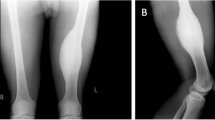Summary
A case of “adamantinoma” of the tibia is reported.
10 years ago a giant cell tumor with fibrous dysplasia had been diagnosed in a biopsy taken from the same site of cystic bone changes. These findings may occur as reaction in the periphery of “adamantinomas” of long bones.
By this experience the importance was emphasized, to obtain tissue from the center portion of the tumor to include the typical epithelial islets pathognomonic for “adamantinomas”, which in our case, were found only 10 years after the first operation. Our patient was treated by curetting and filling of the defect with bony splinters. At this time, 8 months after surgery, he is without complaints and in full use of his diseased leg.
Zusammenfassung
Es wird über ein „Adamantinom” der langen Röhrenknochen in der Tibia berichtet.
Vor 10 Jahren wurde in einer Biopsie, die aus der gleichen Stelle entnommen wurde, ein Riesenzelltumor mit fibröser Dysplasie diagnostiziert. Diese Befunde können als Randreaktion bei „Adamantinomen” der langen Röhrenknochen auftreten.
Dadurch wird die Wichtigkeit unterstrichen, nicht nur Gewebe aus der Tumorperipherie für die Biopsie zu gewinnen, um z. B. die typischen epithelialen Tumoranteile eines „Adamantinoms” mitzuerfassen, die hier erst 10 Jahre später entdeckt werden konnten.
Die Patientin wurde durch eine Tumorausräumung und Ausfüllung des Defektes mit Beckenkammspänen behandelt und ist z. Z. beschwerdefrci. „Adamantinome” der langen Röhrenknochen sind maligne oder zumindest „lokal maligne” Tumoren (Schajowicz et al., 1972), die destruktiv lytisch wachsen und in 50% rezidivieren Bowie in 35% metastasieren (Faunce,1977). Histologisch sind sie charakterisiert durch umschriebene, anscheinend epitheliale Zellnester in einem spindelzelligen Stroma. Dieser histologische Aufbau zeigt Ähnlichkeiten zum Adamantinom oder Ameloblastom der Kieferknochen.
Im vorliegenden Fall handelt es sich um eine 23jährige Patientin mit einem „Adamantinom” der Tibia. Eine vor 10 Jahren von der gleichen Stelle entnommene Biopsie hatte Veränderungen im Sinne eines „braunen Tumor” und einer fibrösen Dysplasie gezeigt.
Similar content being viewed by others

Literatur
Baker, P. L., Dockerty, M. B., Coventry, M. B.: Adamantinoma (so-called) of the long bones. J. Bone Jt. Surg.36-A, 704–720 (1954)
Cohen, D. M., Dahlin, D. C., Pugh, D. G.: Fibrous dysplasia associated with adamantinoma of the long bones. Cancer15, 515–521 (1962)
Dahlin, D. C.: “Adamantinom” of long bones. In: Bone tumors, pp. 204–211. Springfield/Ill.: Charles C. Thomas 1970
Delarue, J., Chomette, G., Brocheriou, C.: Adamantinome du tibia et “dysplasie fibreuse”. Ann. Anat. path.9, 337–378 (1964)
Donner, R., Dikland, R.: Adamantinoma of the tibia. A longstanding case with unusual histological features. J. Bone Jt. Surg.48-B, 138–144 (1966)
Faunce, H. F.: Adamantinoma long bones and ameloblastomajaw. In: Röntgendiagnostik der Skeleterkrankungen, Ranninger, K., Teil 6, pp. 417–427. Berlin-Heildelberg-New York: Springer 1977
Gloor, F.: Das sogenannte Adamantinom der langen Röhrenknochen. Virchows Arch. path. Anat.336, 489–502 (1963)
Huvos, A. G., Marcove, R. C.: Adamantinoma of long bones. A clinicopathological study of fourteen cases with vascular origin suggested. J. Bone Jt. Surg.57, 148–154 (1975)
Moon, N. F.: Adamantinoma of the appendicular skeleton. A statistical review of reported cases and inclusion of 10 new cases. Clin. Orthop.43, 189–213 (1965)
Rosai, J.: Adamantinoma of the tibia. Electron microscopic evidence of its epithelial origin. Amer. J. Clin. Path.51, 786–792 (1969)
Schajowicz, F., Ackerman, L. V., Sissons, H. A., Sobin, L. H., Torloni, H.: Histological typing of bone tumours, pp. 44–45. Geneva: WHO 1972
Spjut, H. J., Dorfman, H. D., Fechner, R. E., Ackerman, L. V.: Adamantinoma. In: Tumors of bone and cartilage. Second Series. Fascicle 5, pp. 315–323. Washington: AFIP. 1971
Theros, E. G., Ishak, B. W.: An exercise in radio logic-pathologic correlations. Radiology89, 747–752 (1967)
Unni, K. K., Dahlin, D. C., Beabout, J. W., Ivins, J. C.: Adamantinomas of long bones. Cancer34, 1796–1805 (1974)
Weiss, S. W., Dorfman, H. D.: Adamantinoma of long bone. An analysis of nine new cases with emphasis on metastasizing lesions and fibrous dysplasia-like changes. Hum. Path.8, 141–153 (1977)
Wolfort, B., Sloane, D.: Adamantinoma of the tibia. J. Bone Jt. Surg.20, 1011 (1938)
Zand, A., Chambers, G. H., Street, D. M.: So-called “adamantinoma of long bone”. Clin. Orthop.86, 178–182 (1972)
Author information
Authors and Affiliations
Rights and permissions
About this article
Cite this article
Konrad, E.A., Meister, P. & Stotz, S. „Adamantinom” der tibia and reaktive knochenveränderungen. Arch. Orth. Traum. Surg. 92, 297–301 (1978). https://doi.org/10.1007/BF02341813
Received:
Issue Date:
DOI: https://doi.org/10.1007/BF02341813



